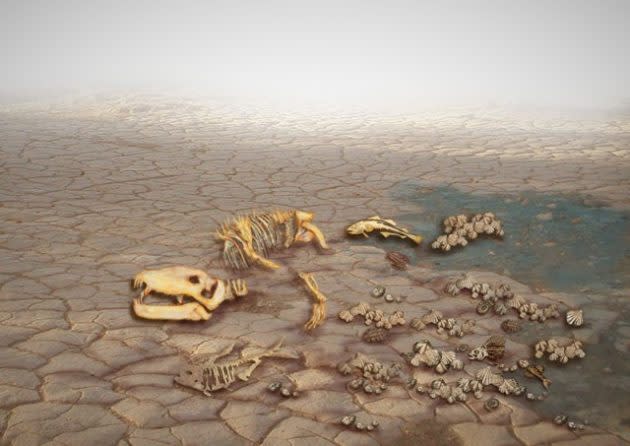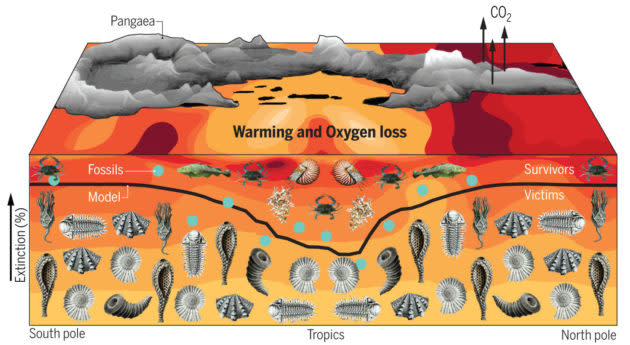How climate change choked ancient life to death — and why it could happen again

Scientists say rapidly warming oceans played a key role in the world’s biggest mass extinction, 252 million years ago, and could point to the risks that lie ahead in an era of similarly rapid climate change.
The latest analysis, published in this week’s issue of the journal Science, puts together computer modeling of ancient ocean conditions and a close look at species characteristics to fit new pieces into a longstanding puzzle: What were the factors behind the Permian-Triassic mass extinction, also known as the Great Dying?
The Permian-Triassic die-off dwarfed the extinction event that killed off the dinosaurs almost 190 million years later. About 70 percent of land-based species became extinct, but the toll was even greater in Earth’s seas. An estimated 96 percent of marine species were snuffed out.
One leading factor was a rash of volcanic eruptions in a region known as the Siberian Traps, which contributed to an increase in atmospheric greenhouse-gas levels. That contributed to a runaway warm-up in the oceans as well, probably fueled in part by a release of undersea methane.
To tease out the impact of warming oceans on ancient species, a team of researchers from the University of Washington and Stanford University ran computer models of ocean conditions and animal metabolism, and checked the results against the traits seen in ancient fossils as well as in modern-day species.
“This is the first time that we have made a mechanistic prediction about what caused the extinction that can be directly tested with the fossil record, which then allows us to make predictions about the causes of extinction in the future,” study lead author Justin Penn, a UW doctoral student in oceanography, said in a news release.
The computer modeling showed that the warmer oceans lost about 80 percent of their oxygen. About half of the ocean seafloor, mostly at deeper depths, became completely oxygen-free.
What effect would those conditions have had on marine species? Penn and his colleagues began by matching up the ancient conditions with the traits of 61 modern-day marine species that parallel creatures from the Permian era, ranging from corals to sharks.
They found that the effects of oxygen depletion would have dealt the gravest blow to species living far from the tropics. The species that had the best chance of survival were the ones that could shift their habitat closer to the equator.
“Very few marine organisms stayed in the same habitats they were living in — it was either flee or perish,” said study co-author Curtis Deutsch, a UW associate professor of oceanography.
To double-check the findings, Stanford’s Jonathan Payne aod Erik Sperling analyzed the distribution of species in the late Permian era, as documented by the Paleoceanography Database, a virtual archive of published fossil collections. The analysis confirmed that species in high-latitude habitats suffered the most.
Penn said the geographical pattern and computer modeling both point to the “kill mechanism” for Permian species. “The agreement between the two indicates this mechanism of climate warming and oxygen loss was a primary cause of the extinction,” he said.

The findings are also in line with a scenario that Deutsch previously laid out for the extinction, in which warming oceans led to a speed-up in animal metabolism at the same time that the oxygen levels required to fuel that mechanism were running low. That scenario would add to the bad news for high-latitude species.
“Since tropical organisms’ metabolisms were already adapted to fairly warm, lower-oxygen conditions, they could move away from the tropics and find the same conditions somewhere else,” Deutsch explained. “But if an organism was adapted for a cold, oxygen-rich environment, then those conditions ceased to exist in the shallow oceans.”
The computer models suggest that low-oxygen conditions would account for more than half of the Permian-Triassic loss of diversity in marine species. The researchers say the rest of the effect might be explained by other factors, such as ocean acidification and the rise and fall of photosynthetic organisms.
Penn noted that the models could be applied to future ocean conditions as well as past conditions, with worrisome results.
“Under a business-as-usual emissions scenario, by 2100, warming in the upper ocean will have approached 20 percent of warming in the late Permian. And by the year 2300, it will reach between 35 and 50 percent,” he said. “This study highlights the potential for a mass extinction arising from a similar mechanism under anthropogenic climate change.”
The research behind the Science paper, “Temperature-Dependent Hypoxia Explains Biogeography and Severity of End-Permian Mass Extinction,” was funded by the Gordon and Betty Moore Foundation and the National Science Foundation.
More from GeekWire:
Fossil hunters show off Triassic treasures from Antarctica at the Burke Museum
Triassic Park: Paleontologists publish piles of papers on dinosaurs and their relatives
A fossil named after Burke Museum curator tells whale of a tale about evolution
Microsoft co-founder Paul Allen partners with NOAA to explore climate changes in deep ocean water
